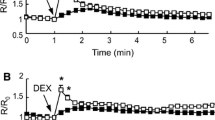Summary
The effects of ammonium salts in concentration similar to those found in plasma in course of hepatic encephalopathy (2–4 mM) were studied in brain slices in order to clarify how glutamate synapses are affected by this pathological situation. Electrophysiological (mice cortical wedge preparations) and biochemical techniques (inositol phosphates and cyclic AMP measurements) were used so that the function of both the ionotropic and metabotropic glutamate receptors was evaluated. Ammonium acetate (2–4 mM), but not sodium acetate reduced the degree of depolarization of cortical wedges induced by different concentrations of N-methyl-D-aspartic acid (NMDA) or (S)-alpha-Amino-3-hydroxy-5-methyl-4-isoxazolepropionic acid (AMPA). This reduction was non-competitive in nature and did not reverse during the experimental period (90 min). In a similar manner, ammonium acetate reduced the formation of inositol phosphates induced by (1S,3R)-1-amynocyclopentane-1,3-dicarboxylic acid (1S,3R-ACPD) (100μM), the prototype agonist of metabotropic glutamate receptors. When the metabotropic glutamate receptors negatively linked to the forskolin-stimulated cyclic AMP formation were evaluated, ammonium acetate significantly hampered forskolin effects and its actions were additive with those of the metabotropic glutamate receptor agonist 1S,3R-ACPD. In conclusion, our results suggest that toxic concentrations of ammonium impair the function of glutamate receptors of NMDA and AMPA type and of the metabotropic glutamate receptors linked to inositol phosphate formation while they functionally potentiate the action of glutamate agonists on the receptors negatively linked to adenylyl cyclase.
Similar content being viewed by others
References
Burton NR, Smith DA, Stone TW (1988) A quantitative pharmacological analysis of some excitatory amino acid receptors in the mouse neocortex in vitro. Br J Pharmacol 93: 693–701
Carlà V, Moroni F (1992) General anaesthetics inhibit the responses induced by glutamate receptor agonists in the mouse cortex. Neurosci Lett 146: 21–24
De-Knegt RJ, Kornhuber J, Schalm SW, Rushe K, Riederer P, Tan J (1993) Binding of the ligand [3H]MK-801 to the MK-801 binding site of the N-methyl-D-aspartate receptor during experimental encephalopathy from acute liver failure and from acute hyperammonemia in the rabbit. Metab Brain Dis 8: 81–94
Fagg GE, Foster AC, Ganong AH (1986) Excitatory amino acid synaptic mechanism and neurological function. Trends Pharmacol Sci 7: 357–363
Fan P, Lavoie J, Lé NLO, Szerb JC, Butterworth RF (1990) Neurochemical and electro-physiological studies on the inhibitory effect of ammonium ions on synaptic transmission in slices of rat hippocampus: evidence for a postsynaptic action. Neuroscience 37: 327–334
Felipo V, Grau E, Minana MD, Grisolia S (1993) Ammonium injection induces an N-methyl-D-aspartate receptor mediated proteolysis of the microtubule-associated protein. J Neurochem 60: 1626–1630
Hamberger AC, Hedquist B, Nystrom B (1979) Ammonium ion inhibition of evoked release of endogenous glutamate from hippocampal slices. J Neurochem 33: 1295–1302
Harrison NL, Simmonds MA (1985) Quantitative studies on some antagonists of NMDA in slices of rat cerebral cortex. Br J Pharmacol 84: 381–391
Herrero I, Miras-Portugal MD, Sanchez-Prieto J (1992) Positive feedback of glutamate exocytosis by metabotropic presynaptic receptor stimulation. Nature 360: 163–166
Kvamme E, Lenda K (1982) Regulation of glutaminase by exogenous glutamate, ammonia and 2-oxoglutarate in synaptosomal enriched preparation from rat brain. Neurochem Res 7: 667–678
Lombardi G, Alesiani M, Leonardi P, Cherici G, Pellicciari R, Moroni F (1993) Pharmacological characterization of the metabotropic glutamate receptor inhibiting D-[3H]Aspartate output in rat striatum. Br J Pharmacol 110: 1407–1412
Maddison JE, Watson WEJ, Dodd PR, Johnston GAR (1991) Alterations in cortical [3H]Kainate and [3H]AMPA binding in a spontaneous canine model of chronic hepatic encephalopathy. J Neurochem 56: 1881–1888
Marcaida G, Felipo V, Hermenegildo G, Miñana MD, Grisolia S (1992) Acute ammonia toxicity is mediated by NMDA type of glutamate receptors. FEBS 296: 67–68
Moroni F, Lombardi G, Moneti G, Cortesini C (1983) The release and neosynthesis of glutamic acid are increased in experimental models of hepatic encephalopathy. J Neurochem 40: 850–854
Moroni F, Lombardi G, Carlà V, Pellegrini-Giampietro DE, Carassale GL, Cortesini C (1986) The content of quinolinic acid and of other tryptophan metabolites increases in brain regions of rats used as experimental models of hepatic encephalopathy. J Neurochem 46: 869–874
Moroni F, Alesiani M, Galli A, Mori F, Pecorari R, Carla V, Cherici G, Pellicciari R (1991) Thiokynurenates: a new group of antagonists of the glycine modulatory site of the NMDA receptor. Eur J Pharmacol 199: 227–232
Nakanishi S (1992) Molecular diversity of glutamate receptors and implications for brain function. Science 258: 597–603
Peterson C, Giguere JF, Cotman CW, Butterworth RF (1990) Selective loss of NMDA-sensitive glutamate binding sites in rat brain following porta-caval anastomosis. J Neurochem 55: 386–390
Rao VLR, Agrawal AK, Murthy ChRK (1991) Ammonia-induced alterations in glutamate and muscimol binding to cerebellar synaptic membranes. Neurosci Lett 130: 251–254
Rao VLR, Murthy ChRK, Butterworth RF (1992 a) Glutamatergic synaptic dysfunction in hyperammonemic syndromes. Metab Brain Disease 7: 1–20
Rao VLR, Murthy ChRK (1992 b) Hyperammonemic alterations in the metabolism of glutamate and aspartate in rat cerebellar astrocytes. Neurosci Lett 138: 107–110
Ruggiero M, Corradetti R, Chiarugi V, Pepeu GC (1987) Phospholipase C activation induced by noradrenaline in hippocampal slices is potentiated by GABA-receptor stimulation. Embo J 6: 1595–1598
Tanabe Y, Nomura A, Masu M, Shigemoto R, Mizumo N, Nakanishi S (1993) Signal transduction. Pharmacological properties and expression patterns of two rat metabotropic glutamate receptors, mGluR3 and mGluR 4. J Neurosci 13: 1372–1378
Theoret Y, Davies MF, Esplin B, Capek R (1985) Effects of ammonium chloride on synaptic transmission in the rat hippocampal slice. Neuroscience 14: 798–805
Tossman U, Delin A, Eriksson LS, Ungersted U (1987) Brain cortical amino acids measured by intracerebral dialysis in portacaval shunted rats. Neurochem Res 12: 265–271
Author information
Authors and Affiliations
Rights and permissions
About this article
Cite this article
Lombardi, G., Mannaioni, G., Leonardi, P. et al. Ammonium acetate inhibits ionotropic receptors and differentially affects metabotropic receptors for glutamate. J. Neural Transmission 97, 187–196 (1994). https://doi.org/10.1007/BF02336140
Received:
Accepted:
Issue Date:
DOI: https://doi.org/10.1007/BF02336140




